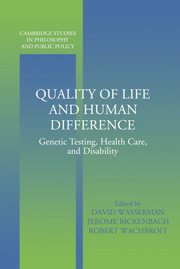Book contents
- Frontmatter
- Contents
- Contributors
- Acknowledgments
- Introduction
- 1 Assessing Quality of Life: Clinical versus Health Policy Uses
- 2 Predicting Genetic Disability while Commodifying Health
- 3 Preventing Genetically Transmitted Disabilities while Respecting Persons with Disabilities
- 4 Disability, Ideology, and Quality of Life: A Bias in Biomedical Ethics
- 5 Values for Health States in QALYs and DALYs: Desirability versus Well-Being and Worth
- 6 Preventing the Existence of People with Disabilities
- 7 Where Is the Sin in Synecdoche? Prenatal Testing and the Parent-Child Relationship
- 8 The Social Context of Individual Choice
- 9 Disability and Health Systems Assessment
- Index
1 - Assessing Quality of Life: Clinical versus Health Policy Uses
Published online by Cambridge University Press: 03 December 2009
- Frontmatter
- Contents
- Contributors
- Acknowledgments
- Introduction
- 1 Assessing Quality of Life: Clinical versus Health Policy Uses
- 2 Predicting Genetic Disability while Commodifying Health
- 3 Preventing Genetically Transmitted Disabilities while Respecting Persons with Disabilities
- 4 Disability, Ideology, and Quality of Life: A Bias in Biomedical Ethics
- 5 Values for Health States in QALYs and DALYs: Desirability versus Well-Being and Worth
- 6 Preventing the Existence of People with Disabilities
- 7 Where Is the Sin in Synecdoche? Prenatal Testing and the Parent-Child Relationship
- 8 The Social Context of Individual Choice
- 9 Disability and Health Systems Assessment
- Index
Summary
INTRODUCTION
The cruel quip “The operation was a success but the patient died” expresses a common anxiety that medicine's criteria of success may be too narrow. Fixed on the goal of removing or ameliorating the symptoms – if not correcting the underlying physiological abnormality – medical practice can sometimes seem professionally inattentive to the impact that a particular disease or treatment may have on a patient's well-being beyond the specific signs and symptoms of the disease. In response to these concerns there has been, at least since the 1970s, growing clinical attention to and research on the use of so-called quality-of-life (QOL) measurements to inform treatment decisions.
Hundreds of these QOL instruments are currently available, many of which are finely tailored to specific diseases or sets of symptoms (McDowell and Newell, 1996). They typically consist of identifying a set of outcomes or consequences arising from a particular disease – physical or emotional functioning, patient self-perceptions and experiences, social limitations, and so on. This set can be called the QOL profile of the disease. Through a method of scoring that is determined to be both reliable and responsive, the disease and the various treatment options are evaluated in terms of their impact on each of the concerns identified in the profile. For example, ambulatory oxygen might well relieve the symptoms of someone suffering from a lung disease; nevertheless, its impact on the patients QOL profile – its effect on his daily activities, how he feels about himself, and so on – might well indicate that carrying a tank of oxygen around results in a lower quality of life and so, arguably, is not the best treatment for this patient's condition.
- Type
- Chapter
- Information
- Quality of Life and Human DifferenceGenetic Testing, Health Care, and Disability, pp. 27 - 42Publisher: Cambridge University PressPrint publication year: 2005
- 1
- Cited by



